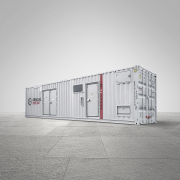HVO: From Commitment to Reality
Genesal Energy’s sustainability commitment is tangible, reflected in real-world projects. One such initiative is the integration of HVO (Hydrotreated Vegetable Oil) into generator set testing—an important step towards a cleaner energy model that maintains the reliability and quality for which the company is known.

HVO is a second-generation biofuel produced from organic waste such as used cooking oils and animal fats. These feedstocks undergo a hydrotreatment process that removes impurities and enhances fuel properties, resulting in a product with characteristics very similar to—if not superior to—conventional fossil diesel. One of its main advantages is that it can be used in existing engines, fuel tanks and storage systems without the need for modification, allowing direct deployment within current infrastructure.
Every step towards a more sustainable energy model must be based on independent validation, technical reliability, and a commitment to quality.
In addition to its compatibility, HVO offers key environmental benefits. It can reduce lifecycle CO₂e emissions by up to 90% compared to standard diesel, supports the circular economy by repurposing waste, and avoids the ethical conflicts often associated with first-generation biofuels derived from food crops. As a result, HVO has become a key tool in the energy transition: a practical, progressive and realistic pathway towards industrial decarbonisation. It is already part of Genesal Energy long-term sustainability strategy.
This solution is particularly relevant in sectors where energy reliability is critical and environmental requirements are increasingly strict—such as data centres, defence, healthcare and telecommunications. In these environments, HVO allows organisations to move forward with decarbonisation goals without compromising operational security or power continuity.

Ensuring Quality in Real-World Conditions
The shift to HVO was not based on laboratory trials or isolated testing. Genesal Energy sought to validate the fuel’s behaviour under real-world operating conditions, applying the same level of technical rigour required of every system component.
To achieve this, two generator sets representative of typical product applications were selected: a 100 kVA and 200 kVA units in Spain. Both were already in active service, supplying energy to installations under standard daily load and operational demands. These conditions offered an authentic view of how HVO performs in routine use and within the environments where it must deliver value.
Real-world testing and laboratory analysis confirm that HVO is a high-quality, dependable fuel solution—ready to meet the challenges of the energy transition.
Fuel samples were taken directly from the gensets, without altering or manipulating the product. These were submitted to an independent, accredited laboratory for full testing and verification against all required specifications and standards for safe, efficient use in diesel engines.
This approach reflects the company’s technical philosophy: every step towards a more sustainable energy model must be based on independent validation, technical reliability, and a commitment to quality. It is not enough for a fuel to be cleaner—it must also meet the performance and durability standards that define Genesal Energy solutions.
Test Results: Confirming HVO’s Quality and Reliability
The laboratory analysed the samples in accordance with UNE-EN 15940, the European standard for paraffinic synthetic and bio-based diesel fuels. Key parameters assessed included:
- Density: Crucial for energy yield per combustion cycle. The measured density fell within the standard limits, ensuring consistent engine performance without the need for recalibration or risk of increased consumption.
- Kinematic viscosity: Essential for proper fuel flow, lubrication, and injector spray pattern. The tested HVO met all viscosity requirements, supporting complete combustion and preventing deposit formation or clogging.

- Distillation curve: Confirmed stable fuel volatility across temperature ranges, ensuring efficient evaporation and ignition under varying load conditions.
- Cold behaviour: The fuel demonstrated excellent performance in low temperatures, avoiding filter blockage or crystallisation. This makes it well suited to variable climates and reduces the need for additional maintenance precautions.
- Cetane number: Indicative of ignition quality under compression. The high cetane value contributed to smoother starts, fewer emissions on ignition, and stable engine operation throughout usage.
- Water and solid content: Low levels were recorded, within safe limits, reducing the risk of corrosion, wear, and system contamination—key to maintaining genset durability.
Overall, the results confirm that HVO complies with all regulatory and technical requirements for safe diesel engine operation. Most importantly, it offers seamless integration with existing systems, enabling immediate adoption in projects where full electrification is not yet feasible from a technical or economic standpoint. This positions HVO as a realistic and effective solution for decarbonisation without sacrificing performance or reliability.

Conclusión
Real-world testing and laboratory analysis confirm that HVO is a high-quality, dependable fuel solution—ready to meet the challenges of the energy transition. Its adoption supports a dual goal: reducing the carbon footprint of distributed generation systems while maintaining the security and effectiveness expected in critical infrastructure.
HVO is a second-generation biofuel produced from organic waste such as used cooking oils and animal fats.
Genesal Energy’s use of HVO is not a symbolic gesture but a strategic commitment combining technological innovation, environmental responsibility and technical excellence. Every step forward is backed by data, independent validation, and a clear focus on delivering reliable, sustainable energy solutions.
Looking ahead, the company will continue to explore and validate emerging technologies that enable clients to decarbonise their operations with confidence—because sustainability is not something to declare, but something to prove.












































